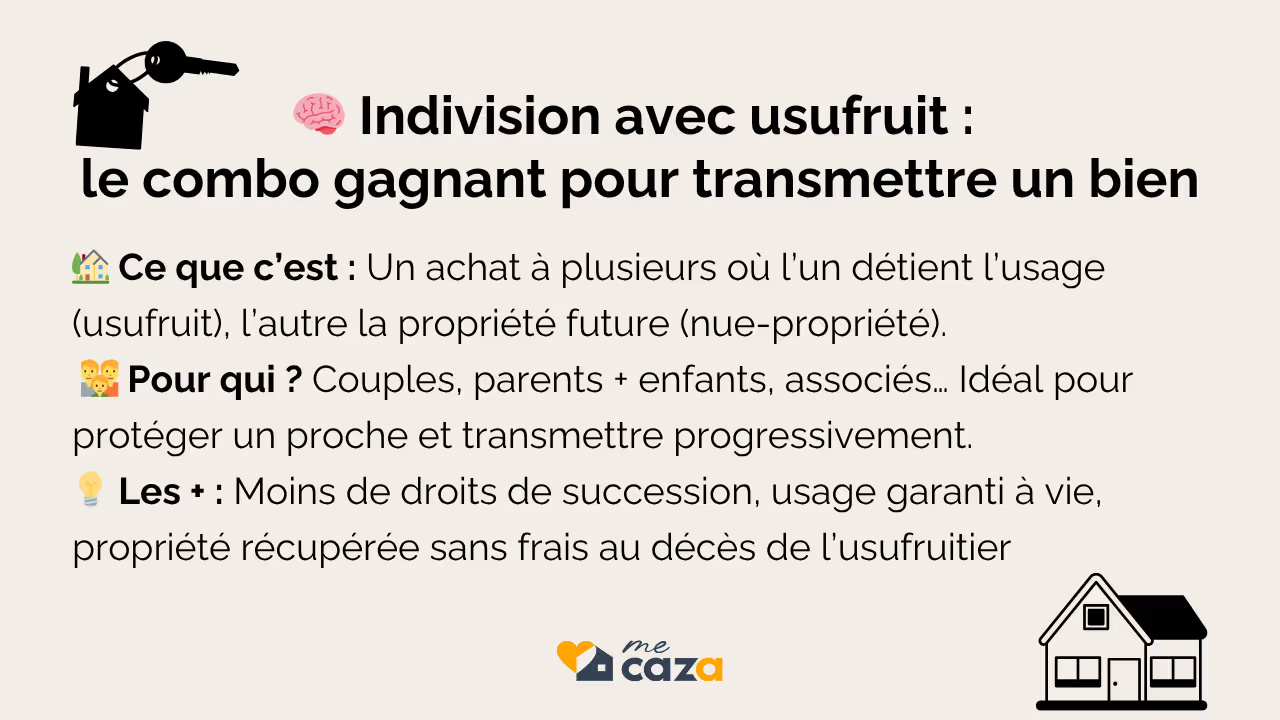Buying jointly with usufruct: The 2025 guide to optimize your real estate purchase with several people
Are you thinking of buying a property with several people while protecting your loved ones? Discover how joint ownership with usufruct can combine flexibility, transmission and legal security.
📅
14/7/2025

Buying a property together is already a strategic approach, but combining it with a division of ownership such as usufruct allows you to go even further. This asset arrangement, although technical, offers very interesting tax, inheritance and management advantages.
In this article, find out in detail how Buy jointly with usufruct can become a powerful tool for protection and transmission.

🧾 Definition: what is a joint ownership purchase with usufruct?
The purchase in joint ownership with usufruct combines two legal concepts: indivision, where several people own a property together, and the Dismemberment of property, where we separate freehold into usufruct (the right to use the property or to receive income from it) and Bare property (the ownership of the property without the right of use).
Usufruct vs bare ownership: key concepts
THEusufructuary can live in the property or rent it, while the Bare owner holds real ownership of the property, but without enjoying it until the usufruct is extinguished.
Indivision: property shared between several people
In joint ownership, each co-purchaser has a Quota. They may be persons with the same rights or with different rights, as in the case of a usufructuary and several naked owners.
How is usufruct combined with indivision?
It is possible to acquire a property where A person owns the usufruct and Others the bare property, while being All in undivided. For example, this allows a parent to keep the use of the property while transmitting it to their children during their lifetime.
Want to know more about buying jointly? Read this article.
👥 Who can buy jointly with usufruct?
This formula is flexible and can be adapted to various family or wealth profiles. Here are a few common cases.
Families: parents, children, siblings
Parents can buy a property with their children, while maintaining usufruct. This facilitates the transmission of assets without losing the use of the property.
Couples: married, in a civil union, cohabiting
A couple can opt for a cross dismemberment : one acquires usufruct, the other bare ownership, in order to protect each other while preparing the succession.
Investors or asset partners
Investors can structure a purchase by awarding usufruct to a corporation or to a parent, while the children own bare ownership, which allowsoptimize fiscally the investment.
🎯 Why combine indivision and usufruct?
This arrangement has numerous legal, fiscal and family advantages. It is used in particular in management and transmission strategies.
Tax optimization and succession
The bare property reduces inheritance tax. Upon the death of the usufructuary, the bare owner becomes the full owner at no additional cost.
Spouse or parent protection
Dismemberment allowsensure the lifelong use of the property to a surviving spouse, while organizing transmission to the children.
Progressive transmission of assets
It facilitates partial donations with reserve of usufruct, allowing maintain control while transmitting the good.
⚙️ How does this legal structure work?
For the operation to be safe and effective, rigorous implementation is essential.
Distribution of shares between usufructuary and bare owner
Each co-purchaser is granted a right (usufruct or bare ownership) according to his objectives and his financial contribution. This should be clearly stated in the notarial act.
Drafting an adapted notarial act
The purchase must be formalized before a notary, who will specify the Nature of everyone's rights, the value of the usufruct and the conditions of management.
Undivided agreement with dismemberment
To avoid disputes, it is advisable to write a indivision agreement, integrating specific clauses related to dismemberment (works, rents, resale...).
💡 Concrete examples of the use of usufruct in joint ownership
Let's see through two concrete cases how this setup works in real life. These examples make it possible to better understand the practical implications of indivision coupled with usufruct.
Example 1: Usufructuary parent and children-owners
Mr. Bernard buys an apartment with his two children. He retained the usufruct and gave them bare ownership. He can live there for life, and when he dies, the children own it at no cost.
Example 2: Purchase in pairs with cross dismemberment
Marc and Sophie, not married, buy a house together. Everyone has usufruct on the other's share and bare ownership on its own part. This guarantees the survivor the possibility of staying in the property.
💰 How much does it cost?
The cost depends on several legal and fiscal elements related to the nature of the dismemberment.
Notary fees and taxation on usufruct
Deed costs are calculated based on the value of each right. The usufruct is assessed according to the age of the usufructuary (tax scale of article 669 CGI).
Estimation of the usufructuary value
Example: for a 60-year-old usufructuary, the value of the usufruct is 40% of the value of the property, bare ownership represents the remaining 60%.
Cost of a personalized indivision agreement
Having an agreement drawn up can cost between €800 and €1,500 depending on the complexity, but this investment significantly reduces future conflicts.
🛑 What are the risks and disadvantages?
Although this structuring offers advantages, it also includes areas of fragility that should not be overlooked.
Risk of disagreement between co-owners
In joint ownership, all major decisions (sale, major works, etc.) require The agreement of all co-indivisors. This may result in deadlocks, especially if one of them wants to sell while the others oppose it.
Limits of the usufructuary in management
The usufructuary cannot carry out certain works without the agreement of the naked owner. He also cannot sell the property alone, which limits its margin of maneuver.
Blocking when selling the property
Resale requires the agreement of the usufructuary and the nues-owners. If interests diverge, the sale may be suspended or require legal proceedings.
🛠️ How do you secure this type of purchase?
Good security is based on well-written documents and effective legal expectations.
Essential clauses in the indivision agreement
It is recommended to include:
- Work management methods,
- The fate of rental income,
- The conditions for exit from joint ownership or resale.
Role of the notary in security
A notary is a key player. He ensures the legal validity and clarity of the quotas and advises on the best clauses to integrate.
Anticipate the exit of joint ownership or the extinction of usufruct
Plan in the agreement what will happen:
- Property in the event of the death of the usufructuary,
- Methods for the repurchase of shares.
🔍 Differences between simple indivision, dismemberment and SCI
There are several options available to you when it comes to buying together or structuring the ownership of a property. To make the right choice, it is essential to fully understand the differences between traditional joint ownership, joint ownership with usufruct, and real estate civil society (SCI). Here is a clear comparison chart to guide you.
Comparative: advantages/disadvantages
When should you choose SCI rather than joint ownership?
La SCI is recommended when:
- There are several heirs or partners,
- You want to organize a professional rental management,
- You are aiming for a progressive transmission optimized for tax purposes.
✅ FAQ : Buying jointly with usufruct
Who can benefit from usufruct?
Anyone named in the notarial act, often a parent, spouse, or family member.
Can you resell usufruct property?
No, the usufructuary alone cannot sell the property. You need the agreement Nus-owners for a joint sale.
What happens when the usufructuary dies?
Usufruct Turns off automatically and full ownership goes to the bare owner at no additional cost.
Can the naked owner live in the property?
No, unless authorized by the usufructuary. He can't occupy it or rent it out.
What rights does the naked owner really have?
He is Title owner, but can only enjoy the property at the end of the usufruct. He must be consulted for any major modification of the property.
Can you borrow jointly with usufruct?
Yes, but it requires a adapted assembly. The bank will analyze the situation of each co-owner and the rights they hold.
🏁 Conclusion: is this a strategy to adopt in 2025?
THEPurchase in joint ownership with usufruct represents an intelligent strategy for buying together while protecting property and family interests of each one. Whether it is to pass on property to your children, to secure your spouse or to optimize your taxation, this arrangement deserves to be seriously studied.
However, it requires a rigorous legal foresight, the help of a notary and smooth communication between co-owners to guarantee the success of the project. In 2025, as asset management becomes more and more strategic, this solution appears to be a real secure wealth opportunity.

Article rédigé par Mélanie Jacquet,
Experte immobilière du blog MeCaza.
To go further

26/11/2025
What is real estate asset management? Understanding Real Estate Asset Management
Real estate asset management aims to manage, value and make a portfolio of properties profitable. Discover its role, its objectives and the trends of the profession.
Lire l'article ⭢
24/11/2025
What is a real estate expert?
The real estate expert helps you build, optimize and transmit your assets. Discover its role, its missions and how to choose it well.
Lire l'article ⭢
21/11/2025
What is a land business? Understand, invest, choose
What is a land business? Definition, economic model, taxation, advantages and advice for investing in sustainable real estate assets.
Lire l'article ⭢
